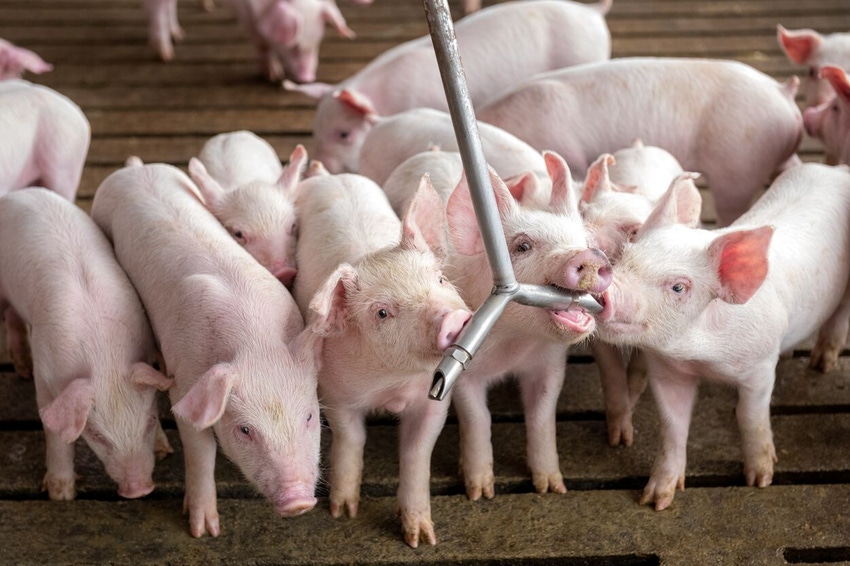Water loss appeared to be reduced if pigs were provided water in the feeder either in combination with an outside water nipple or only in the feeder.
September 29, 2022

Watering options for growing pigs include placement of water nipples outside of dry feeders or use of wet-dry feeders where the water nipple is placed inside the feeder. In some cases, the wet-dry feeder is combined with the use of an outside auxiliary water nipple.
It may be hypothesized that providing water inside the feeder will increase feed intake of pigs, which potentially may reduce digestibility of energy, dry matter and nutrients, but data to address this hypothesis have not been reported. Therefore, two experiments were conducted to test the null-hypothesis that the location of the water nipple does not influence the standardized ileal digestibility of amino acids, the apparent total tract digestibility of dry matter and energy, or the digestible, metabolizable, or net energy of diets.
Three watering options
The same corn-soybean meal based diet was used in two experiments. All nutrients were included in the diet at or above the requirement for growing pigs (NRC, 2012). In both experiments, there were three treatments:
Dry feeder with no water, but a water source located outside the feeder.
A wet-dry feeder with a water nipple inside the feeder, but no water outside the feeder.
A wet-dry feeder with a drinking nipple inside the feeder and also a water source outside the feeder.
Pigs were allowed ad libitum access to feed and water in both experiments.
Digestibility of amino acids
In the first experiment, six barrows (initial weight: 27.53 kg) with a T-cannula installed in the distal ileum were used. Six pigs were allotted to one of the three treatments using a replicated 3 × 3 Latin square design with three pigs and three periods in each square. All pigs were also fed a nitrogen-free diet during an additional period to determine basal endogenous losses of AA. Each period lasted seven days with ileal digesta being collected on day 6 and 7 for eight hours using standard procedures.
The diets and ileal digesta were analyzed for crude protein amino acid, and dry matter and values for ileal digestibility of dry matter, crude protein and amino acids was calculated. Results indicated that dietary treatments did not impact apparent ileal digestibility of dry matter or the standardized ileal digestibility of crude protein or amino acids. It therefore appears that placement of the water source in relation to the feed is not critical in terms of maximizing amino acid digestibility.
Concentrations of digestible, metabolizable and net energy
In the second experiment, 24 pigs (initial BW: 50.2 kg) were housed in groups of four pigs in six indirect calorimeter chambers. Pigs were allotted to one of the three treatments using a replicated 3 × 3 Latin square design with three chambers and three periods in each square. There was therefore two chambers per diet in each period for a total of six replicate chambers per diet for the three periods. Each chamber was equipped with a stainless steel tri-bar floor, stainless steel fecal screens, and urine pans for total, but separate, collection of fecal and urine materials.
Temperature and relative humidity were maintained at the same conditions in all chambers. Feces and urine were collected for six days after seven days of adaptation. Total heat production was calculated using values for O2 consumption and CO2 and CH4 production. Fasting heat production was also measured. Apparent total tract digestibility of gross energy and dry matter were calculated for each treatment and concentrations of digestible energy, metabolizable energy and net energy were calculated as well.
Results indicated that there were no differences among the three watering options in feed intake, gross energy intake, feces weight, fecal gross energy output, urine gross energy output, total or fasting heat production, digestibility of dry matter and gross energy or concentrations of digestible, metabolizable or net energy (Table 2). The weight of urine was, however, greater (P
Based on these results it was concluded that under the conditions of these experiments, feed intake was not increased by placing the water nipple in the feeder, and therefore, digestibility of amino acids, dry matter and energy was not impacted by water source placement. As a consequence, quantities of digestible, metabolizable and net energy that pigs obtain from a corn-soybean meal diet is not impacted by placement of the water source. It is however, possible that under commercial conditions, where there are 20 to 25 pigs per pen, results could be different.
In conclusion, ileal digestibility of dry matter or amino acids was not different for pigs provided water only in the feeder compared with pigs provided water only outside the feeder or both inside and outside the feeder. Total tract digestibility of energy and concentrations of digestible, metabolizable and net energy were also not affected by the different water options. However, water loss appeared to be reduced if pigs were provided water in the feeder either in combination with an outside water nipple or only in the feeder.
Source: Su A Lee, Diego A. Rodriguez and Hans H. Stein, who are solely responsible for the information provided, and wholly owns the information. Informa Business Media and all its subsidiaries are not responsible for any of the content contained in this information asset.
You May Also Like



